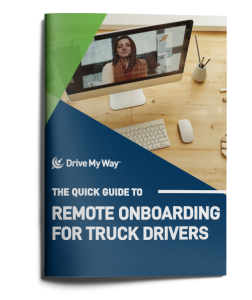 Staff changes are always difficult, no matter what industry or company you work for. Whether you’re dealing with one of your best recruiters leaving the company or trying to train a brand new recruiter on how the trucking industry operates, these situations can have a dramatic impact on your department if not handled correctly. If your recruiting team has recently undergone changes, here are some tips on how to keep the disruption to a minimum.
Staff changes are always difficult, no matter what industry or company you work for. Whether you’re dealing with one of your best recruiters leaving the company or trying to train a brand new recruiter on how the trucking industry operates, these situations can have a dramatic impact on your department if not handled correctly. If your recruiting team has recently undergone changes, here are some tips on how to keep the disruption to a minimum.
When a Recruiter Leaves
Make an Action Plan
The worst thing that can happen when a recruiter leaves your company is for them to have been handling some important responsibility, and for no one to know what to do once they’re gone.
If you’re in a situation where a driver gives you two weeks’ notice, have them use those two weeks to take stock of all the things they do. If there’s some responsibility they handle that no one else on your team does, have them create process documents and tutorial videos for them. Then you can work with the recruiter to come up with a plan for who will take over those responsibilities in the interim while you try to replace them.
Conduct an Exit Interview
We’ve talked at length about the importance of conducting exit interviews for drivers who are leaving your organization, but the same is true for recruiters.
If possible, you always want to find the reason why they’re leaving your organization. It could be as simple as a big increase in compensation that you’re not willing or able to match. Other times, it could be because of the culture of the team, unrealistic (as they perceive them) recruiting goals, or disputes with individual team members.
Sometimes reasons that the recruiter presents may be part of “he said, she said” drama, but other times it could indicate a big problem in your team that could cause over recruiters to leave as well. No matter what the reason is, it’s important to learn what it is and investigate it quickly.
When Bringing in a New Recruiter

Make Responsibilities Known Early
Have you ever started a job, only to find after your introductory meetings that you have no idea what you’re supposed to be doing? This happens far too often in many workplaces, and especially recruiting.
Make sure that from the start, your recruiters understand their what their job functions and responsibilities are. This doesn’t mean that they have to be perfect at their jobs off the jump, but they shouldn’t be wondering two weeks in, “Is this my job or someone else’s?”
Keep Mentoring, Even After Training
Recruiting is a difficult job normally, but recruiting in the trucking industry presents an even bigger challenge. Truck drivers, especially experienced ones, are savvy job seekers who will want to know that the recruiter they’re talking to knows their stuff.
Drivers may ask technical questions that have to do with runs, home time, or the equipment itself that recruiters most likely won’t know the answers to without at least a few months to a year’s experience. While this situation can’t be avoided, you can make it easier for your new recruiters by making sure you’re always available to help in these situations.
A good exercise is to ask your recruiters to make a note of any technical questions they didn’t have an answer to. Then you can hold a weekly meeting where you go over these questions and the ideal answer to them. If you’re short on time, this can also be done via an email blast to the department.
Another way to show new recruiters that you’re a mentor to them is by taking calls with drivers in front of them. Training is great, but hearing an actual recruiter talk to a real driver is a great way to mentor your new recruiters and show that you’re one of them, and part of a team; not just their supervisor.
Staff changes can’t be avoided. What can be avoided is having a lapse in productivity because of a staff change. Keep these tips in mind the next time there’s a new or exiting recruiter in your department, and you’ll be fine.


 Comprehensive CDL Recruitment Solutions
Comprehensive CDL Recruitment Solutions

 The most important part of strong communication with drivers is good listening. This means you actually take time and effort to hear drivers’ concerns and then address them. Good listening isn’t just reactive. Don’t just wait for drivers to come to you with their concerns. Be curious enough to inquire about their needs and questions.
The most important part of strong communication with drivers is good listening. This means you actually take time and effort to hear drivers’ concerns and then address them. Good listening isn’t just reactive. Don’t just wait for drivers to come to you with their concerns. Be curious enough to inquire about their needs and questions. Sometimes, the medium is the message. Choosing the proper communication method can make the difference between having successful conversations with drivers or leaving them frustrated. Some issues are too long or complicated to discuss over text or email. Calling drivers’ cell phones is the most popular way to communicate with drivers for a good reason.
Sometimes, the medium is the message. Choosing the proper communication method can make the difference between having successful conversations with drivers or leaving them frustrated. Some issues are too long or complicated to discuss over text or email. Calling drivers’ cell phones is the most popular way to communicate with drivers for a good reason.
 This one cannot be overstated. None of your communication strategies and methods are going to work if drivers don’t feel that you’re treating them with respect.
This one cannot be overstated. None of your communication strategies and methods are going to work if drivers don’t feel that you’re treating them with respect.



 It’s not breaking news that print media is on the decline. While ads in newspapers and magazines may have been the primary advertising channel decades ago, readership has gone down significantly.
It’s not breaking news that print media is on the decline. While ads in newspapers and magazines may have been the primary advertising channel decades ago, readership has gone down significantly.  You’ve seen these ads everywhere: Ones with 20-30 bullets listing out every facet and minute detail of a job. But the more information available for prospective hires, the better, right? Think again. In that very early stage of the job search, driver candidates are usually just looking for a few pieces of key information so they can decide if they want to learn more about the position.
You’ve seen these ads everywhere: Ones with 20-30 bullets listing out every facet and minute detail of a job. But the more information available for prospective hires, the better, right? Think again. In that very early stage of the job search, driver candidates are usually just looking for a few pieces of key information so they can decide if they want to learn more about the position.  To simply call social media popular anymore is a gross understatement. It’s become so entwined with people’s lives that we almost can’t imagine life without it. This is why it’s important for carriers who are looking to reach more drivers through their job ads to build up a presence on these social media sites.
To simply call social media popular anymore is a gross understatement. It’s become so entwined with people’s lives that we almost can’t imagine life without it. This is why it’s important for carriers who are looking to reach more drivers through their job ads to build up a presence on these social media sites. 






 To support strong mental health in your fleet, support good dietary and
To support strong mental health in your fleet, support good dietary and  Having strong, healthy relationships is closely linked with positive mental health. That extends far beyond the walls of the home. Build a company
Having strong, healthy relationships is closely linked with positive mental health. That extends far beyond the walls of the home. Build a company 
 National job uncertainty has been a hallmark of 2020. With that in mind, it’s more important than ever to
National job uncertainty has been a hallmark of 2020. With that in mind, it’s more important than ever to  In addition to transparency, consistency is critical during uncertain times. It’s so important that in 2019, Harvard Business Review found that
In addition to transparency, consistency is critical during uncertain times. It’s so important that in 2019, Harvard Business Review found that  Public recognition is most meaningful as a way to connect drivers when it is paired with private or internal recognition as well. Drivers will quickly see through any companies that praise in public and don’t value drivers in private. In addition to external marketing campaigns, take time to reach out to drivers individually.
Public recognition is most meaningful as a way to connect drivers when it is paired with private or internal recognition as well. Drivers will quickly see through any companies that praise in public and don’t value drivers in private. In addition to external marketing campaigns, take time to reach out to drivers individually. 



 Home time should be clearly stated in the hiring contract. While it may seem unnecessary, putting home time in writing is good protection for both the company and drivers. If your policy is in writing, it ensures consistency among drivers. If you do have
Home time should be clearly stated in the hiring contract. While it may seem unnecessary, putting home time in writing is good protection for both the company and drivers. If your policy is in writing, it ensures consistency among drivers. If you do have  If drivers stay with your fleet for long enough, they will likely request time at home outside their typical policy at some point. Additionally, new drivers might ask about for more time at home in a hiring interview. Before those conversations arise, consider how you can offer flexibility in a way that works with you.
If drivers stay with your fleet for long enough, they will likely request time at home outside their typical policy at some point. Additionally, new drivers might ask about for more time at home in a hiring interview. Before those conversations arise, consider how you can offer flexibility in a way that works with you. 







